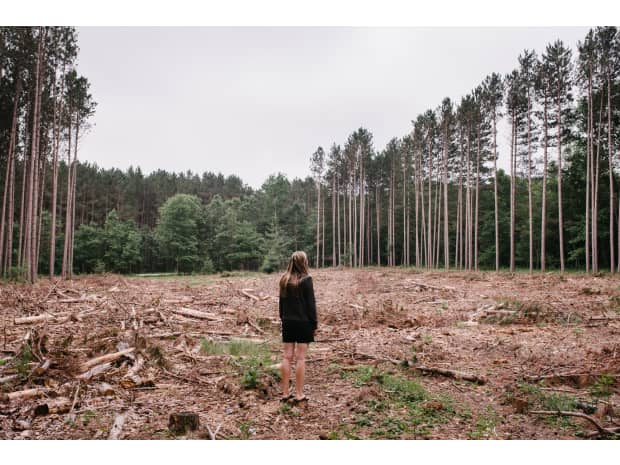
Is Plastic Really Getting Recycled In the U.S.?
Recyclable plastic packaging is a myth; here’s why plastic recycling doesn’t work.
Read More


Last Updated: June 15, 2022
Plastic packaging is a problem, but we’re ready to solve it. Learn how we’re shaking up the industry by replacing single-use plastics with sustainable alternatives, one product at a time.
Each year, over 300 million tons of plastic are produced — and around 50% of that is dedicated to single-use products like packaging. Plastic pollution kills 1 million marine animals every year, it contributes to the emission of greenhouse gases at each point of its life cycle, and only 5% of all plastic produced ends up being recycled. Take into consideration that the average plastic bottle can take hundreds of years to break down, and it becomes alarmingly clear that plastic is an omnipresent threat all over the globe.
Single-use plastic packaging dominates the consumer goods industry, but we’re innovating out of products that contain plastics and into products designed for circularity: Read on to learn the steps we’re taking to achieve our plastic-free goals – plus some tips to reduce your plastic usage at home.
If plastic is so terrible for ocean life and the planet, why is it still the go-to for packaging? The answer is pretty simple — plastic beats out pretty much every other material in terms of cost-effectiveness and durability.
Plastic is able to stand up against damage and corrosion. It’s also lightweight, which makes it easier and less expensive to ship and create more products. And finally, plastic is cheaper than aluminum and glass – and when recycled properly, plastics can even be melted down and remanufactured into new products. All of these factors contribute to plastic becoming the golden girl of the consumer goods industry.
Beyond Plastic™ is our effort to spur our industry toward long-term, scalable solutions that do not rely on single-use plastics. Some plastic in products and packaging is currently unavoidable given the absence of feasible alternatives. Plastic-free solutions either don’t yet exist, aren’t cost competitive, or aren’t available at scale. Aluminum bottles, for example, require a very thin plastic inner coating to keep the liquid from interacting with the aluminum. Given these realities, Beyond Plastic™ is our commitment to celebrate progress and push ourselves and our broader industry forward
In 2023, we integrated our Beyond Plastic™ badges into the Grove.com experience. The new digital badging system enables customers to make informed, educated purchasing decisions to reduce their consumption of single-use plastic. Products with our Beyond Plastic™ badges signify the best available solution that significantly reduces or eliminates single use plastic waste.
Customers can look for three badges on our site: 100% Plastic-free, 95%+ Plastic-free, and No Single-use Plastic. These badges make it easier to shop products that reduce single-use plastic, or are refillable or reusable.
Charting this course alone would mean reducing our product offerings, rather than giving customers one place for the best available solutions. We lead our industry in radical transparency — products that meet our Beyond Plastic™ standard continue to increase across our net revenue and assortment. For more information on the progress we are making, see our latest Plastic Scorecard.
We’re committed to using our voice to advance legislation that supports the progress of the most material crises we have identified, including plastics and recycling. Our mission to move Beyond Plastic™ is meant to transform our industry, not just our products. In order to do this, we know that Grove needs to participate in conversations about relevant legislation. We do this through our advocacy efforts.
Familiarize yourself with products that are — and aren’t — recyclable. We’ve got a list of 11 things you probably think are recyclable, but actually do more harm than good when they end up in your recycling bin.
Ditch the recycling bin altogether with reusable alternatives to common household products. Swaps like reusable straws and cotton pads are easy and affordable to make, but we’ve also got tips to turn your pantry into an eco-friendly haven if you’re up for a fun weekend project.
Learn how to reduce plastic when you order take-out. Simple tips like saying no to plastic utensils can help reduce plastic consumption when you order food for delivery. If you’re picking food up, bring your own containers instead of using plastic or styrofoam containers from the restaurant. Easy, right?

Recyclable plastic packaging is a myth; here’s why plastic recycling doesn’t work.

Deforestation is a serious global problem that’s on the verge of becoming a catastrophic global crisis. What is deforestation, and how can you help stop it?

More than 14 million tons of plastic waste end up in the ocean every year. Here’s how it ends up there, why it’s bad — and how you can help keep it clean.

Make better choices about your food, beauty, and cleaning products by learning about greenwashing and the steps you can take to actively avoid it from Grove Sustainability Expert Alexandra Bede.